The Tools of Pericology
Pericological Tools
A "Pericological Tool" refers to any practical device, method or process, designed or adapted to anticipate, detect and prevent systemic perils in human, biological or technological contexts, drawing inspiration from the cooperative dynamics of nature. Anchored in the pillars of Pericology (observation, proactive prevention, contextual adaptation), it translates validated scientific knowledge, notably from bio-inspired collaboration, into applied solutions. These tools are intuitive, accessible and do not presuppose perfect human cooperation, promoting systemic resilience in the face of critical thresholds.
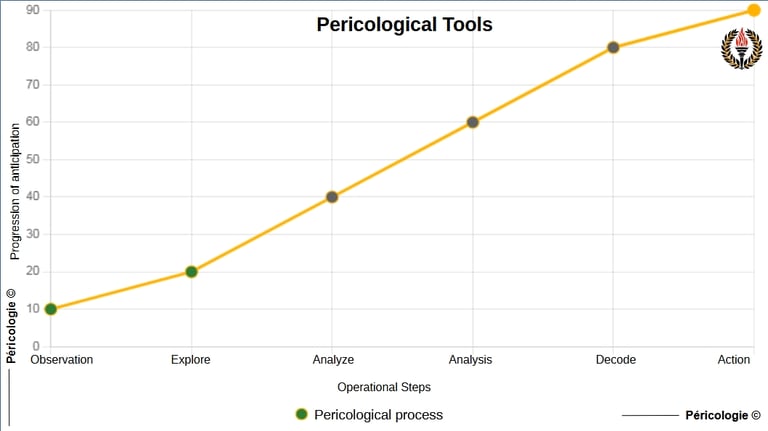

Pericological Tools
Diagram of pericological tools
Pericological Example
Context : A small coastal town faces weak signals of marine erosion (increase in extreme tides, occasional flooding of dikes). Local data (water level sensors) indicate a potential systemic risk, amplified by coastal urbanization (positive loop). Traditional approaches (post-crisis dike reinforcement) are costly and delayed.
Pericological Application : The pericological tool " Bio-Inspired Anticipation Matrix" is deployed. Inspired by coral reefs (redistribution of flows to avoid collapse), this matrix maps measurable signals (tidal height, soil erosion) and models interdependencies (urbanization, marine ecosystem). Step 1 (Explore) : Data collection via IoT sensors. Step 2 (Analyze) : Evaluation of critical thresholds (e.g.: submersion at +1.5 m). Step 3 (Decode) : Identification of a tipping point (dam collapse in 18 months). Action : Implementation of a plant barrier (mangroves) to absorb tides, reducing the danger before the crisis.
Etymology
Tool : From the Latin ūtilis (“useful, functional”), derived from ūtor (“to use, to employ”).
Pericological : Compound of the Latin pēriculum ("danger, risk") and the Greek peri ("around, nearby"), with -logy (from the Greek logos , "speech, study").
Pericological Sources
Ecosynpraxy
The methodological heart of Pericology, "Ecosynpraxy" refers to the bio-inspired approach that translates the cooperative dynamics observed in fauna and flora into practical, intuitive, and scientifically validated tools to anticipate and prevent biological perils. It promotes human collaboration, self-management, and feedback in contexts where communication is limited or rapid decisions are required. Unlike approaches presuming ideal human cooperation, Ecosynpraxy adapts to practical realities, managing biological perils via simple solutions inspired by nature, such as the coordination of fish schools or the resilience of forests. It constitutes the founding basis of Pericology 's bio-inspired identity and depends on Holopraxy for mixed or non-biological perils.
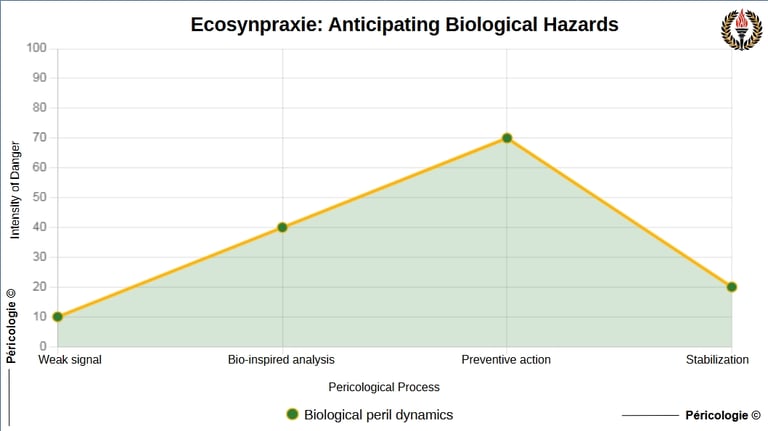

Ecosynpraxy
Ecosynpraxy Diagram
Pericological Example
Context : In an interconnected local agricultural context (e.g., a 50-hectare cooperative farm in a temperate zone, 2025), a biological hazard emerges in the form of an incipient pest infestation (e.g., aphids amplified by a positive loop of accelerated reproduction due to a microbial imbalance). Weak signals include a subtle increase in leaf transpiration (measurable via low-tech sensors) and a 5% reduction in auxiliary biodiversity (e.g., predatory bees). Without anticipation, this reaches a tipping point in 2-3 weeks, threatening 30% of the harvest and the economic balance of the human team (10 farmers). This hazard is purely biological, non-systemic, making Ecosynpraxy ideal as a founding basis, without recourse to Holopraxy for mixed aspects.
Pericological Application : Ecosynpraxytranslates the cooperative dynamics observed in nature (e.g., self-management of ants redistributing pheromones to regulate an invasion) into simple tools for the team. Observation : Detect weak signals via bio-inspired peripheral monitoring (e.g., patrols mimicking animal sentinels). Analysis : Evaluate the positive loop (pest amplification) and identify the critical threshold (density > 10/m²). Action : Apply bio-inspired feedback, such as introducing companion plants (e.g., marigold to attract natural predators), blocking the danger without chemical pesticides.
Etymology
Derived from the Greek oikos ("house", "environment", by extension "ecosystem"), syn ("together", "with") and praxis ("action", "practice").
Pericological Sources
Holopraxy
"Holopraxy" is a central branch of Pericology, adopting a holistic and interdisciplinary approach to anticipate and manage complex non- biological perils, such as socio-economic, technological or systemic crises. It integrates biological, human, technological and systemic dynamics, unifying complementary paradigms (Sociosynpraxy, Technosynpraxy, Cyclosynpraxy) to address interconnected threats. As the central pivot of the discipline, Holopraxy incorporates Ecosynpraxy for the biological aspects of mixed perils, relying on scientific rigor and practical feasibility. It promotes adapted solutions, anticipating tipping points to prevent crisis escalation.
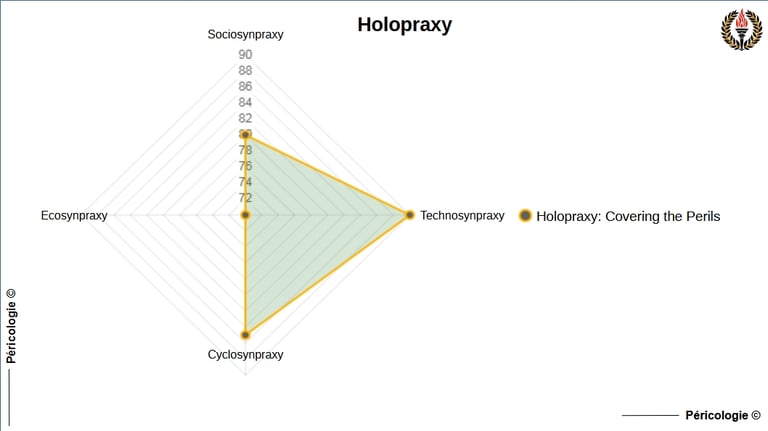

Holopraxy
Holopraxy diagram
Pericological Example
Context : In an interconnected metropolis in 2026, a smart logistics platform (powered by AI) manages urban food flows. Weak signals (recurring delivery delays and increases in energy consumption) indicate a risk of systemic failure, which could lead to supply disruptions and social tensions.
Pericological Application : Holopraxymobilizes an interdisciplinary approach to anticipate this non-biological peril. It integrates : Observation : Analysis of IoT data (measurable signals) and human feedback (weak signals from delivery people). Bio-inspired analysis : Modeling inspired by ecosystems (e.g.: redistribution of flows in an ant colony) to identify a potential tipping point (server overload). Proactive action : Deployment of a multi-agentic algorithm to rebalance flows before the crisis, avoiding disruption.
Etymology
Derived from the Greek holos ("whole", "all") and praxis ("action", "practice"), the term Holopraxy literally means "global action" or "integral practice".
Pericological Sources
Sociosynpraxy
"Sociosynpraxy" is a sub-branch of Pericology, which applies bio-inspired cooperative dynamics to socio-cultural perils. It mobilizes the principles of collaboration, self-management and feedback, drawn from observations of fauna and flora, to anticipate and prevent dysfunctions in human social systems, such as cultural conflicts, polarizations or crises of community cohesion. Pragmatic and anchored in validated scientific bases, it does not presuppose ideal human cooperation, but adapts to contextual realities, favoring rapid and intuitive solutions to preserve social balance.
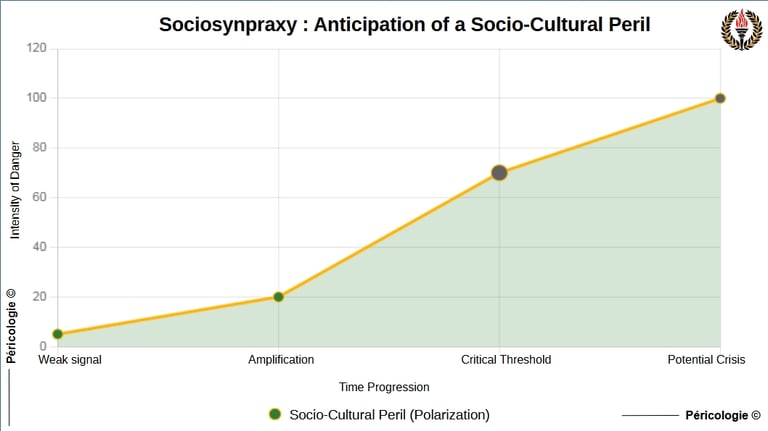

Sociosynpraxy
Sociosynpraxy diagram
Pericological Example
Context : In an urban community of 5,000 inhabitants, socio-cultural tensions are emerging around unequal access to educational resources (e.g., overcrowded schools in some neighborhoods). Weak signals include an increase in complaints on social media and a decrease in participation in community meetings, indicating a risk of polarization (socio-cultural peril). Without intervention, these tensions could reach a tipping point, leading to open conflict or social fracture.
Pericological Application : Sociosynpraxy, a sub-branch of Ecosynpraxy and Holopraxy, applies a bio-inspired approach drawn from the dynamics of cooperation in animal colonies (e.g., ants redistributing resources via decentralized communication). A pericologist observes weak signals (complaints, disengagement), analyzes their severity (risk of polarization), and proposes a proactive action : organizing local participatory workshops, inspired by self-management mechanisms, to equitably redistribute access to educational resources (e.g., community tutoring programs).
Etymology
Socio- : From the Latin socius ("companion, associate"), designating human social interactions and structures.
Syn- : From the Greek sun ("with, together"), emphasizing collective cooperation.
Praxy : From the Greek praxis ("action, practice"), indicating a concrete and methodical application.
Pericological Sources
Technosynpraxy
"Technosynpraxy" is a sub-branch of Holopraxy, within Pericology, which focuses on the anticipation and prevention of complex technological perils affecting interconnected systems. It mobilizes interdisciplinary dynamics (technological, human and systemic) to detect warning signals, analyze critical thresholds and act proactively to counter emerging dysfunctions or crises in technological infrastructures. Inspired by the bio-inspired principles of Pericology, it adapts cooperation and feedback mechanisms observed in nature (such as the self-regulation of ecosystems) to design practical and contextual solutions, without presupposing absolute technological reliability. It relies on scientific rigor and active monitoring to anticipate technological tipping points, promoting systemic resilience.
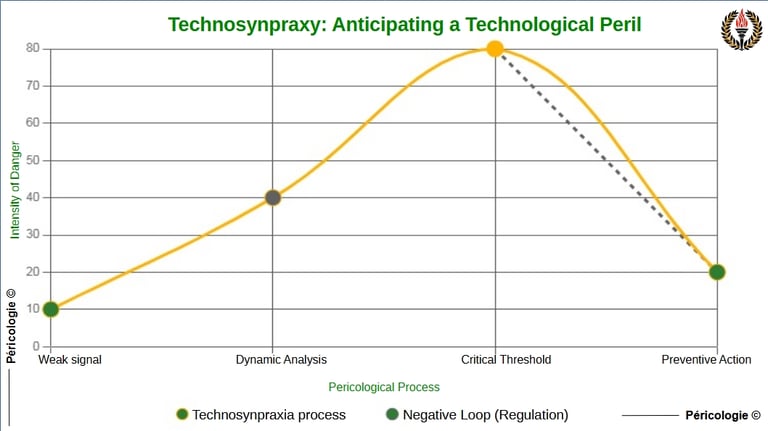

Technosynpraxy
Diagram of technosynpraxy
Pericological Example
Context : In an automated factory using interconnected AI systems for production management, a weak signal is detected : unexplained micro-latencies in machine-to-machine communications. This signal, ignored by standard maintenance protocols, indicates a potential tipping point towards a systemic failure (e.g., production shutdown or amplified cyberattack).
Pericological Application : Technosynpraxyintervenes in three stages : Observation : Identify micro-latencies as weak signals via bio-inspired monitoring, imitating the detection of anomalies in an ecosystem (e.g.: ants spotting an intruder). Analysis : Model the dynamics of latencies as a positive loop (amplification of delays), by crossing machine data with human metrics (operator feedback). Action : Implement a bio-inspired solution , such as a decentralized redistribution of tasks (inspired by swarms), by dynamically reallocating data flows to avoid overload, blocking the danger before the crisis.
Etymology
Techno- : Derived from the Greek tekhnē (τέχνη), meaning "art", "technique" or "know-how", referring to technological systems and tools.
-syn- : From the Greek sun (σύν), meaning "with" or "together", emphasizing the collaborative and interconnected approach.
-praxy : From the Greek praxis (πρᾶξις), meaning "action" or "practice", emphasizing concrete and methodical application.
Pericological Sources
Cyclosynpraxy
A sub-branch of Holopraxy in Pericology, "Cyclosynpraxy" refers to the interdisciplinary and bio-inspired approach dedicated to the anticipation and prevention of systemic perils, that is, emerging threats arising from the complex interconnection between human, technological, biological and environmental systems. It draws on the regulatory dynamics observed in natural ecosystems to model and counter systemic tipping points before they trigger global crises. Cyclosynpraxy is distinguished by its ability to analyze complex interdependencies and propose methodical preventive actions, without presupposing an inherent stability of the systems.

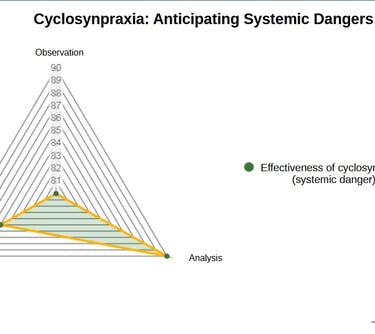
Cyclosynpraxy
Diagram of cyclosynpraxy
Pericological Example
Context : In an interconnected metropolis, a food delivery logistics network relies on IoT sensors, autonomous vehicles, and distribution centers. A weak signal (repeated delays at a logistics node) is detected, risking a cascading supply disruption (systemic tipping point) affecting food security.
Pericological Application : Cyclosynpraxyapplies a bio-inspired approach, inspired by anthills where the redistribution of tasks avoids congestion. Observation identifies the weak signal via the analysis of IoT data (abnormal delays). Analysis models the interconnection of logistics nodes, revealing a risk of positive loop (amplification of delays). Action proposes a dynamic redistribution of deliveries to secondary nodes, adjusted in real time, to stabilize the network (negative loop).
Etymology
Derived from the Greek kuklos ("cycle", "circle"), sun ("together", "with") and praxis ("action", "practice").
Pericological Sources
For enthusiasts
Our links
Message
© 2025. All rights reserved. By Pericology
